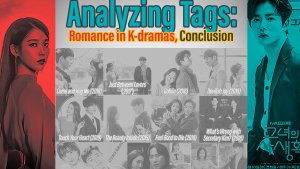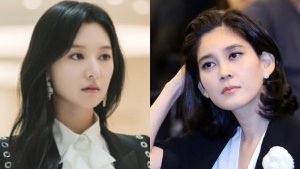 A Tag Analysis: Romance in K-Dramas - Conclusion
A Tag Analysis: Romance in K-Dramas - Conclusion
Hello, dear readers!
It's been a while, hasn't it? In fact, more than a year has gone by since this series of articles started, and now, finally, I've mustered the time to get back to finishing it. But credit where credit is due, @Yuanwei reached out to me to remind me she loved my articles and missed them. So she's a big part of why I finally made time for this hobby alongside all of those who've read, liked, and commented on my previous articles.
So apologies for the long delay and I hope you're still interested in finding out more!
Without further ado, let's get started with an overview of our series for those who aren't familiar with it or just don't remember:
Analyzing Tags: Romance in K-dramas | |
| PART ONE | An overview of the Romance genre that focuses on the formulas used in K-dramas and how we can interpret them within the genre. Specifically, we go over the following tags: "Love Triangle", "Lead Chasing" and "Age Gap". |
| PART TWO | Continues the overview of the formulas used in K-dramas by analyzing the following tags: "Office Romance", "Boss/Employee Relationship," "Cohabitation" and "Childhood Connection". |
| PART THREE (current article) | Focuses on the tags related to the characters; specifically how we tag a female lead vs a male lead when it comes to Romance. Here we will cover the "friendship" tag which includes: "Bromance" & "Sismance" as well as go through the Money-Related (Poor & Rich Leads) and Financial Discrepancy (Poor Lead/Rich Lead) tags. |
| PART FOUR | Continuation of the analysis of how we tag a female lead vs a male lead when it comes to Romance, this time going over tags relating to attributes (strong, weak, smart, etc.) in order to find out and compare what users and drama-creators focus on when considering the genders. |
You may have noticed that, as has become my signature, I've split the Female vs Male Lead Analysis into two articles. This is done in the spirit of keeping my articles more "bite-sized" (I take feedback seriously, after all!) while still being able to cover each subject sufficiently. So worry not, I won't make you sit through a long essay. Though if you still find this one lengthy, at the very least, I hope you'll find it interesting enough to make up for it.
Now, following the structure of the previous articles, I'm again focusing only on the Romance Genre within K-Dramas. In addition, for the sake of accuracy (and working with the biggest percentages), I reduced the sample of dramas. As I mentioned before, the tag system was implemented in October of 2017 so checking shows from that year forth gave me the best chance to find and cover dramas with enough tags.
So the tallied numbers that make up the backbone of this article correspond to Romance K-Dramas added to the MDL databased which finished airing between January of 2017 and May of 2020: |
YEAR | 2017 | 2018 | 2019 | MAY 2020 | TOTAL SAMPLE |
# of Dramas | 120 | 154 | 148 | 18 | 465 Dramas |
Now, before we get into it, I think it's important to point out that this analysis isn't absolute and infallible. There is, after all, a margin of error which involves the following points:
- First, I didn't check to see if all the dramas had tags when I tallied the numbers. Which in retrospect, I should've done, but that might've been too much for one person with limited free time to handle. Such dramas like Eat, Fight, and Live Together, Everyday Loves, Something Between Us and Oh My Captain (to name a few) where tallied despite having almost no tags besides the general ones. So take the numbers with a grain of salt, as the percentages should probably be higher than what I'm showing.
- By the way, if anyone feels up to the task of finding out how many dramas within our searching parameters have no tags and would like to provide the numbers, I could account for that in the last article and would, of course, give proper thanks and credit! \(• ◡ •)/
- Although I'd planned to only tally full-length dramas, I had no way of filtering my search to avoid also tallying web series. So those got included not only in this article but also in previous articles.
- Keep in mind that, since we're dealing with the human element and everyone perceives things differently, not all tags may be accurate. But, with no way to check and filter them out (though I did some when I considered the tags were wrong), the numbers wouldn't account for that "user discrepancy/error".
Having established that, let's get started with the easiest and probably the least controversial comparison, shall we?
FRIENDSHIPSBROS BEFORE SIS OR SIS BEFORE BROS? | |||
Only 118 (25%) Romance Dramas have been tagged with Bromance and/or Sismance. From those, the breakdown is as follows: | |||
 | |||
75 Dramas have the Sismance tag. Which translates to 16% overall. | However, when we compare how many dramas have only Sismance vs how many have only Bromance, it becomes clear that the depiction of a deep friendship between women in Romance Dramas is harder to find. | 87 Dramas have the Bromance tag. Which translates to 18% overall. | |
 | |||
 |  |  | |
While there's still a preference for depicting (and tagging) Bromance over Sismance in K-Dramas, the difference is admittedly a lot smaller than I expected. Nonetheless, the numbers still support the idea that Bromance is the preferred choice of friendship building in a Romance K-Drama.
In fact, if writers had to choose between only Bromance and only Sismance, it's 2x more likely they would pick the former. And if they happen to showcase Sismance, it's still 2x more likely they'll also include Bromance in that drama (and probably give it more screentime as well).
Based on my own viewing experience, I'd wager that if we were to tag the friendships only between the leads and second leads, we would widen the gap. How could we not? I don't think I'm alone in noticing that the Second Female Lead (2FL) is often portrayed, introduced, and treated as an adversary of the Female Lead (FL) for most if not the entire length of the drama. Such is the case for dramas like Just Between Lovers, Suspicious Partner, Catch the Ghost, Crash Landing on You and My ID is Gangnam Beauty.
I especially remember how Soo Ah, the 2FL from My ID is Gangnam Beauty, received a lot of hate from the comment section when the show was airing. Even more interesting was the fact that she had a better presented back story and a more redeeming arc in the webtoon than in the show. But that's a discussion for another time, so let's get back on track.
Of course, we may also come across the occasional drama where the Male Lead (ML) and Second Male Lead(2ML) never see eye to eye, such as I Picked up a Star on the Road, My Absolute Boyfriend, Where Stars Land, The Ghost Detective and Catch the Ghost.
And yet, even if the Male characters remain unfriendly, they are never written as vicious as Female characters. Just compare the following clips taken from the same episode of a recent drama:
Catch the Ghost (2019) | |
 |  |
Ha Ma Ri (2FL) treats Yoo Ryung (FL) with contempt as she quickly tries to establish "who's boss" and mark Kim Woo Hyuk (ML) as her territory. | Kim Woo Hyuk (2ML) seizes an opportunity to spend time with his crush Yoo Ryung, much to Go Ji Suk's (ML) chagrin. |
Notice that the Male Leads relationship is treated more comically than hostile. Whereas, the relationship between the Female Leads is cut-throat and toxic. While the Male Leads established reluctant respect for each other, the Female Leads remain at odds throughout the drama. Of course, we can argue that the Male Leads already had a pre-existing working relationship so that may impact how they treat each other. While the Female Leads met under intense and less than ideal circumstances. But even their possessiveness is showcase very differently. With the Males being sweeter in their approach as opposed to the Females (specifically the 2FL). | |
I also think the most prevalent type of Sismance introduces female characters with a pre-established friendship (and not necessarily between the FL and 2FL). That alone makes their relationship less intense because there is neither room nor a need to develop that friendship further. Such is the case with I'm Not a Robot, Her Private Life, Hyena, The Beauty Inside, and Love with Flaws. Though there are still notable exceptions to that rule like Fight for my Way and Because This Is My First Life, where the friendships are still developed as an important part of the plot.
However, the intensity of the friendship determines whether it'll ultimately become memorable. As such, chances are, you may remember more "Bromances" than "Sismances." And how could you not when the latter often time doesn't have the same attention to development as the former?
When it comes to Bromance, most dramas not only showcases but focuses on building and evolving the men's friendship. The most memorable ones usually have the men meet as rivals or adversaries who later find common footing. Such are the cases for Wok of Love, Mr. Sunshine, Strong Woman Do Bong Soon, and Meow, the Secret Boy. In fact, take a look at this example:
Wok of Love (2018) | |
 |  |
Start of the Drama | Past the halfway point of the Drama |
It would be a lie to say the Bromance between Poong (ML) and Chil Seong (2ML) wasn't a central part of the plot of Wok of Love. Take the building of this relationship out, and you destroy the heart of the show. I'd even go as far as to assure you, the Bromance here overtook and overshadowed the romance by a long mile! | |
Very rarely do we find dramas where the FL and 2FL build a friendship after a rocky start. In fact, the only recent dramas that spring to mind where the Female Leads start out as adversaries but become reluctant allies and later good friends (complete with badass scenes depicting their new friendships) are The Last Empress, Search WWW, Hyena and, to a certain extent, Mr. Sunshine (but sadly their Sismance doesn't get as much airtime as the bromance does). Take a look at the clips below:
Search WWW (2019) | |
 |  |
Start of the Drama | Past the halfway point of the Drama |
Like with Wok of Love, Search WWW would lose its essence if you take out the relationship between Ta Mi (FL) and Scarlett (2FL). They start off as rivals, with the latter being reluctant to work with Ta Mi, but they end up becoming allies as their respect for each other grow. Of course, at some point, they flawlessly transition to sisters willing to help, support, and protect each other at all costs. | |
Another scenario we see regularly presented in Bromances is having the ML and 2ML -- who are already close friends or even sometimes family (blood-related or adopted) -- fall in love with the same girl, such is the case with Chicago Typewriter, Mama Fairy and the Woodcutter, Love with Flaws, He Is Psychometric, What's Wrong with Secretary Kim, Thirty but Seventeen, and Devilish Joy (to name a few).
Whereas it's rare for an FL and 2FL, with a pre-established friendship, fall for the same guy yet somehow still remain friends. In fact, 2015's She Was Pretty is the only show that comes to mind and one which wasn't included in our current sample.
Another scenario we often see is men pining for a different woman display deep moments of friendship like in A Korean Odyssey, Fight for My Way and Love with Flaws. While fewer dramas seem to give female friendship the same amount of drama/intensity and -- most importantly -- air time, with perhaps a few exceptions such as Because This Is My First Life, Fight for my Way, Love with Flaws, and Search WWW.
And did you noticed I used several dramas as an example for different points? That's because another interesting aspect of this is the number of friendship bonds being depicted. In that respect, I think we can all agree that there's a tendency to depict several brotherly relationships in one drama. While it's extremely rare to see more than one sisterly bond established within a drama.
But what do you think about this subject? Do you find the depiction and treatment of "Bromance" vs "Sismance" different in K-dramas? Which types of friendship portrayals do you like the most or find the most memorable? Share your thoughts in the comments down below!
With that out of the way, let's move onto a VERY rocky subject... money!
FINANCIAL STATUSWHO GETS THE BLING AND WHO GETS THE RAG? | |||
Interestingly enough, it seems that for the last three and a half years, including a very obvious (Rich Lead/Poor Lead) financial discrepancy between the Male and Female Lead has been subsiding. That is not to say, however, that the tag shows a balance between the genders, because as you've probably predicted, the Female Leads gets the short end of the stick with this one. | |||
 | |||
32% have Money-Related tags involving the main leads.(Rich ML, Rich FL, Poor ML & Poor FL)Meaning that... | |||
 | |||
Meanwhile, around 10% have been tag with Money Discrepancy between genders.(Rich Man/ Poor Woman or Rich Woman/Poor Man)Meaning that... | |||
 | |||
Out of that 10% of dramas tagged with a Money Discrepancy... | |||
 | Overall, 33 Dramas have been tagged with a Money Discrepancy, only 9 of those had the Rich woman/Poor Man. However, keep in mind that the tag may not necessarily relate to the main leads. And in fact, that's exactly what's happening given the "Rich man/Poor woman" tag has been defined as: The depiction of friendship, romantic, or sexual relationship between a wealthy man and a poor woman. |  | |
Also, it's important to point out that these numbers reflect the usage of the tags rather than the usage of a financial discrepancy as a plot device to drive or build the "romance" in a drama. In addition, dramas with a financial difference between the leads may still fall through the cracks if they aren't tagged with "rich man/poor woman" and/or "poor woman/rich man". Just think about all the dramas where we are introduced to a male lead who is either rich or much better off financially than the female lead. Yet, because the female lead is not technically "poor", but perhaps middle class, we don't get a proper tag for that financial discrepancy. Such is the case for dramas like: My Holo Love, My Strange Hero, The Game: Towards Zero, and Forest. These exceptions might yield some insight into why the number of dramas tagged with a "Financial Discrepancy" seems so low, especially when compared to the "Money-Related" tags. So keep in mind that these numbers aren't absolute and are bound to interpretation and driven by the data available during the writing of this article. In fact, let's dig a little deeper into the Money-Related tags. | |||
MONEY-RELATED TAGSPoor ML, Poor FL, Rich ML, and Rich FL | |||
 | MOST LIKELY SCENARIOwhen money tags are at play |  | |
1 out of 10 Dramas------- feature a "poor female lead" (or at least one worth tagging). |  | ||
 |
| 1 out of 10 Dramas------- Will feature a "rich male lead" (or at least one worth tagging). | |
 |  |  | |
It's a sad reality that in this day and age, Romance in fiction still hinges on the Male being financially well-off, while the Female tends to be in financial crisis and in need of saving. This is supported by the numbers, which show that whenever there's a significant financial difference between the leads, it's 7x more likely for the male lead to be the rich one.
But let's dig deeper into the numbers of the Rich vs Poor tags separately so we can better compare their use between the genders.
POOR FEMALE VS POOR MALE LEAD | ||||
 | TAG USAGE |  | ||
57% of Romance Dramastagged with a Poor ML are also tagged with a Poor FL. | ||||
So 7/10 Tagged Dramaswithin our 57%, will feature ONLY a Poor Female Lead. | Whereas 2/10 Tagged Dramaswithin our 57%, will feature ONLY a Poor Male Lead. | |||
 |  | |||
As has been established, a lead tagged as poor is 2x more likely to be female. However, it's important to note that out of our sample of 465 dramas, only 63 Dramas (13%) included a "Poor F/M Lead" tag. From those, 52 Dramas (11%) had the "Poor Female Lead" tag, and only 26 (5.5%) had a "Poor Male Lead" tag. Of course, 15 (3.2%) of the 465 Dramas included both the Poor Male Lead and the Poor Female lead Tag.
This tells us that while the portrayal of "Poor Leads" isn't as prevalent as I'd thought (1/10 dramas), the truth remains that Male Leads are commonly better off than Female leads.
So if the writers have to pick one lead to be the "poor one", 7 out of 10 times, they'll pick the Female Lead to carry and be defined by that burden.
To get an even better picture, let's now take a look at the rich tags.
RICH FEMALE VS RICH MALE LEAD | ||||
 |  |  | ||
29% of Romance Dramastagged with a Rich FL are also tagged with a Rich ML. | ||||
So 2/10 Tagged Dramaswill feature ONLY a Rich Female Lead | Whereas 7/10 Tagged Dramaswill feature ONLY a Rich Male Lead. | |||
 |  | |||
As has been established, a lead tagged as rich is 7x more likely to be male. Out of our sample of 465 dramas, only 65 (14%) had the "Rich Lead" tag and 53 (81%) of those had the "Rich Male Lead" tag. Meaning that 11% of the total dramas of our sample will feature a "Rich Male Lead".
However, only 17 Dramas within our sample included the "Rich Female Lead" tag, which constitutes only 3.6% overall. That means that roughly 1 out of every 28 Dramas will feature a Rich Female Lead.
Even more disappointing is the fact that 5 of those 17 Dramas with a "Rich Female Lead" also included a "Rich Male Lead". This means that, in actuality, only 2.5% of 465 Dramas included ONLY a "Rich Female Lead". Whereas a whopping 11% included ONLY a Rich "Male Lead".
So out of 40 Dramas within our 465 Sampled Shows... | |
1 will include ONLY a "Rich Female Lead" | 4.5 will include ONLY a "Rich Male Lead" |
 |  |
As we've all probably noticed, Male Leads tend to be featured as the financially stable ones of the couple. Which ties in with what we talked about in our previous article regarding cohabitation, where the balance of power is tilted towards the Male Lead, and financial prowess is often portrayed as part of the courting process.
So if the writers have to pick one lead to be the "rich one", 7 out of 10 times, they'll pick the Male Lead.
Also tying in with our previous article, have you noticed how Second Female Leads tend to outnumber the Female Leads when it comes to financial prowess? Such is the case in My Holo Love, Devilish Joy, Love with Flaws, and though not within our sample, The King: Eternal Monarch.
Anyhow, that's it for this article! But don't worry, this subject is not yet exhausted, and the analysis has provided more interesting data to share with you next time. The final article will compare the most common attributes our leads get tagged with based on gender, so start making your bets and ready your hypothesis! Also, if you enjoyed this article, don't forget to thank @Yuanwei for the digital nudge!
Thank you for reading this article! I'd love to hear your thoughts in the comments down below. Here are some questions to get a conversation started:
- Did you enjoy the article? Was it easy to digest?
- Did you also read the previous article? If so, have you tagged any dramas since?
- Was there a subject covered in this article that interested you?
- Do you agree or disagree with my findings and interpretations?
- Do you prefer Bromance over Sismance?
- Which drama do you think portrays the best friendship and why?
- Which data did you find most surprising and/or interesting?
- Do you think writers have started to move away from creating and focusing on the financial gap between the leads as part of the plot in romance dramas?
- Can you think of a drama where you enjoyed how the Female Lead got introduced? If so, what did you like about that most?
- Can you think of a drama where you enjoyed how the Male Lead got introduced? If so, what did you like about that most?
- Which do you think is the most used tag(s) regarding the Male and Female Leads? We'll cover this next time, but I'm curious to see what you all think!















